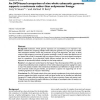NAR
2000
13 years 4 months ago
2000
The WIT (What Is There) (http://wit.mcs.anl.gov/WIT2/ ) system has been designed to support comparative analysis of sequenced genomes and to generate metabolic reconstructions bas...
CANDC
2004
ACM
13 years 4 months ago
2004
ACM
We have addressed the distribution and abundance of 75 transcription factor (TF) families in complete genomes from 90 different bacterial and archaeal species. We found that the p...
BMCBI
2004
13 years 4 months ago
2004
Background: Eukaryotic whole genome sequences are accumulating at an impressive rate. Effective methods for comparing multiple whole eukaryotic genomes on a large scale are needed...
BMCBI
2004
13 years 4 months ago
2004
Background: The discovery of cis-regulatory modules in metazoan genomes is crucial for understanding the connection between genes and organism diversity. It is important to quanti...
BMCBI
2004
13 years 4 months ago
2004
Background: Determination of genetic relatedness among microorganisms provides information necessary for making inferences regarding phylogeny. However, there is little informatio...
BMCBI
2004
13 years 4 months ago
2004
Background: Many current gene prediction methods use only one model to represent proteincoding regions in a genome, and so are less likely to predict the location of genes that ha...
BMCBI
2004
13 years 4 months ago
2004
Background: An increasing number of whole viral and bacterial genomes are being sequenced and deposited in public databases. In parallel to the mounting interest in whole genomes,...
BMCBI
2004
13 years 4 months ago
2004
Background: With ever increasing numbers of closely related virus genomes being sequenced, it has become desirable to be able to compare two genomes at a level more detailed than ...
BMCBI
2005
13 years 4 months ago
2005
Background: Enhancements in sequencing technology have recently yielded assemblies of large genomes including rat, mouse, human, fruit fly, and zebrafish. The availability of larg...
BMCBI
2005
13 years 4 months ago
2005
Background: The sequencing of the human genome has enabled us to access a comprehensive list of genes (both experimental and predicted) for further analysis. While a majority of t...

